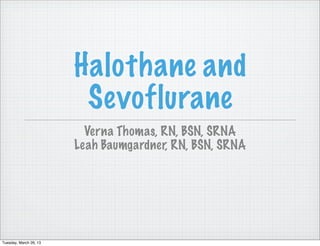
Final
- 1. Halothane and Sevoflurane Verna Thomas, RN, BSN, SRNA Leah Baumgardner, RN, BSN, SRNA Tuesday, March 26, 13
- 2. Halothane History Initially introduced in the mid 1950’s Halothane became the most widely used inhalational anesthetic. Today, its prevalence in modern medicine has diminished to use in Third World countries and veterinary surgery. The arrival of safer anesthetics and better pharmocokinetics in the 1980’s and 1990’s was a substantial contributor to its elimination in American medicine. Tuesday, March 26, 13
- 3. Halothane Functional Group 2-bromo-2-chloro-1,1,1,triflouroethane Tuesday, March 26, 13
- 4. Halothane Metabolism Tuesday, March 26, 13
- 5. Halothane Halothane Sevoflurane HALOTHANE HEPATITIS Boiling Point (°C) 50.2 58.5 Type I (mild): Benign hepatotoxicity, Vapor Pressure @ 20°C (mmHg) 243 120 transient ↑ in serum transaminase Molecular Weight (Da) 197.4 200 and glutathione S-transferase Specific Gravity (g/mL) 1.87 1.50 concentrations, no jaundice or Blood:Gas Partition Coefficient 2.4 0.66 hepatocellular disease evident. Oil:Gas Partition Coefficient 224 53.4 Type II (fulminant halothane MAC (vol%) 0.75 2.05 hepatitis): Massive centrilobular liver Metabolism (% approx) 20 5 necrosis, 50% mortality, fever, jaundice, and marked ↑↑serum transaminase levels, immune Cardiac: ↓BP, ↓HR, ↓CO mediated. Respiratory: ↓VT, ↑RR, ↑PaCO2 Cerebral: ↑CBF, ↑ICP, ↓cerebral metabolic rate, ↓seizures Renal: ↓GFR, ↓renal blood flow, ↓UO Hepatic: ↓hepatic blood flow Tuesday, March 26, 13
- 6. Sevoflurane Inhalation Anesthetic Use: Induction and maintenance of general anesthesia Adult and Pediatric Effects on Organ Systems: Cardiac: moderate reduction in SVR and MAP but myocardial contractility and heart rate unchanged Respiratory depressant but most effective bronchodilator and least irritant of the inhaled anesthetics Relaxes Muscles and attenuates response to noxious stimuli Causes less cerebral vasodilatation and maintains cerebral autoregulation well Contraindications: Malignant Hyperthermia Tuesday, March 26, 13
- 7. Sevoflurane Naming: Functional Group ETHER: R-O-R IUPAC : 1,1,1,3,3,3,-Hexafluoro-2-(fluoromethoxy)-propane Molecular Formula: C4H3F7O Tuesday, March 26, 13
- 8. Sevoflurane PROPERTIES STRUCTURE: Non-polar more polar than alkanes (because of Oxygen) but less polar than alcohols Very slightly water soluable HALOGENATED: with Flourine BOILING POINT: Low - 58.5 degrees Celsius ODOR: Pleasant Tuesday, March 26, 13
- 9. Sevoflurane Oil/gas partition coefficient: 47.2 MAC (Vol%) [in patients aged 30-60y]: 2.05 Blood/gas partition coefficient: 0.69 - low solubility in the blood results in rapid induction, improved control of depth of anesthesia, and fast emergence/ recovery pKa (Acidic and Basic) are not provided but PubChem lists H-Bond Donor: 0 H-Bond Acceptor: 8 Tuesday, March 26, 13
- 10. Sevoflurane Metabolism 95-98% is eliminated through the lungs - rapidly because of low blood/gas solubility The remaining 2-5% is metabolized... Cytochrome P450 System - LIVER - defluorinated to hexaflouroisopropanol (HFIP) with release of inorganic flouride and carbon dioxide - HFIP conjugated with glucuronic acid to HFIP-glucuronide and excreted in the urine Tuesday, March 26, 13
- 11. Sevoflurane Degradation - in the presence of CO2 absorbents used in anesthesia circuits i.e. Baralyme or soda lime Loss of Hydrogen Fluoride produces Compound A fluoromethyl-2,2-difluoro- 1- (trifluoromethyl) vinyl ether (CF2 = C(CF3) OCH2F) Compound A has been shown to be nephrotoxic in rats but not shown in humans - dose related proteinuria, glycosuria, and enzymuria Reduce amount of Compound A by using fresh gas inflows >2L/min Tuesday, March 26, 13
- 12. Sevoflurane 1. Formation of Compound A is directly/inversely proportional to fresh gas inflow??? 2. What characteristic of Sevoflurane is responsible for rapid induction and rapid elimination?? Tuesday, March 26, 13
- 14. References Behne, M., Wilke, H. J., & Harder, S. (1999). Clinical pharmacokinetics of sevoflurane. Clinical pharmacokinetics, 36(1), 13-26. Eger II, E. I. (1991). Metabolism of Sevoflurane. Anesthesia & Analgesia, 73(5), 671-671. Hemmings, H. C., & Hopkins, P. M. (2006). Foundations of anesthesia: basic sciences for clinical practice. Mosby Incorporated. Sevoflurane. In (2012). Drugs.com. Retrieved from http://www.drugs.com/pro/sevoflurane.html Tuesday, March 26, 13
